How Do You Clean/sterelize An Old Chicken House
To successfully grow mushrooms, you'll need to make sure that you lot're using the correct substrate.
Using substrate to abound mushrooms is the equivalent of using soil to abound plants. It's where the mushrooms volition get all of their nutrients while growing.
Just like plants crave soil with different properties, dissimilar kinds of mushrooms prefer specific types of substrates.
By the finish of this guide, you'll know what a mushroom substrate is and what information technology'due south used for. You'll know some common mushroom substrate recipes and the preferred substrates of different mushrooms. Nosotros'll as well teach you how to pasteurize or sterilize substrate and lots more than.
What Is a Mushroom Substrate? What is it Used For?
A mushroom substrate is a material that mushroom mycelium tin can grow and constitute itself in. The substrate provides mushrooms with the nutrients, moisture and free energy they demand to abound and fruit.
At that place are a variety of different substrates that growers apply. Different species of mushrooms have their own preferences. And so it's important to match your mushrooms with the correct substrate to have the best take chances of success.
What Makes a Skillful Mushroom Substrate?
A good substrate is dense in woody, gristly materials similar lignin, cellulose and hemicellulose. (These comprise a lot of carbon, which is the master food source for your mycelium.) Here are a few of import things to keep in mind when choosing a substrate:
- Your substrate needs to have 1 to 2 percent nitrogen. About substrates (like sawdust or straw) need to have additional materials added to them to reach this threshold.
- Your substrate needs to incorporate a small corporeality of magnesium, potassium, calcium, sulfur and phosphorus. Nearly raw substrates already contain these minerals, but this does vary depending on where the textile came from. Y'all'll likely need to experiment here to run across if you need to supplement with additional minerals.
- Your substrate needs to be slightly acidic, with a PH level of about 5 – vi.5. (Some mushrooms, like oyster mushrooms, can tolerate a PH upwardly to about viii.)
- Your substrate needs to accept a practiced construction to enable air commutation. This is necessary for the mycelium to colonize well.
- Your substrate needs a moisture content of 50-70%.
- . Finally, your substrate needs to have an absenteeism of competing organisms. This provides a bare canvas for your mushroom mycelium to thrive.
Preparing Substrate
Before a substrate can be inoculated with mushroom spores or mycelium, first information technology needs to be prepared. Water will need to be added to the substrate and it may also need to be amended with actress nutrients.
Once that is ready, the substrate needs to be sterilized or pasteurized. This kills off any competing mold or bacteria and gives the desired species of mushroom the best chance at taking hold.
If words like inoculation or mycelium seem overwhelming right now, our article How Do Mushrooms Grow? An In-Depth Explanation volition assist to get you lot up to speed.
Mushroom substrate can be placed in a multifariousness of containers. For commercial growers, it'south well-nigh common to pack substrate into large clear plastic bags. Abode growers may set mushroom substrate jars, from mason jars or other small-scale containers, or pack substrate into buckets.
Once your substrate is pasteurized or sterilized and in its final container, so it's time to inoculate with mushroom spawn or spores to starting time the growing procedure.
Y'all will know everything has been washed correctly when you start to see signs of colonization, or the mushroom's mycelium growing and spreading throughout the substrate.
The mycelium will need weeks or potentially months to decompose the substrate and spread completely throughout information technology. In one case colonization is completely finished, the entire substrate will be covered in mycelium. At that point it'southward ready to fruit.
For more information on the rest of the mushroom growing procedure, check out How To Grow Mushrooms: The Ultimate Guide .
Mutual Mushroom Substrate Materials (and Mushroom Substrate Recipes)
There are a broad range of materials that you can apply as a substrate to grow mushrooms. Some are fairly conventional while others are a bit newer and more experimental. Here are some of the most common substrates that mushroom growers are currently using.
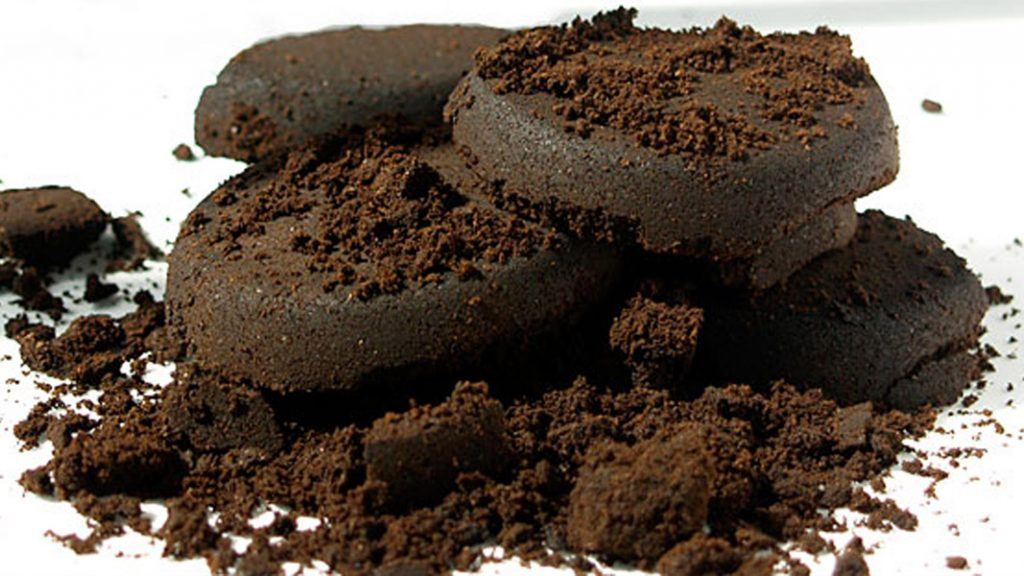
Coffee grounds
Hither at Grocycle, nosotros started off by growing on coffee grounds and we've been doing information technology for years ever since. If yous contact local coffee shops, they will often relieve their spent coffee grounds and give them to yous for free.
I great benefit is that the brewing process pasteurizes the grounds and yous tin start growing in them pretty much right away.
The recipe for growing in coffee grounds is also one of the easiest. Simply combine a kilogram of coffee grounds with 100 grams of mushroom spawn. Yous tin optionally add together 20% harbinger to your mix for better air exchange and a higher speed of colonization.
Harbinger
Straw is another cheap and effective material to use as a substrate. It tin can be purchased at farm stores or most places where yous can find animal feed or bedding. You lot may likewise experiment with similar agronomical wastes like corn stalks.
You can either grow in a substrate composed of 100% straw or add supplements to provide additional nutrients.
At that place are several methods that you can employ to prepare straw substrate. Many use chemicals like peroxide or calcium hydroxide, or rely on fermenting the straw for a calendar week or more than. We prefer to utilise a heating method that'south both quick and organic.
Start past cutting your harbinger into three or iv-inch pieces. If yous're working with big quantities of harbinger, it tin can be easier to use a weed-whacker in a garbage bin to apace shred the material.
To pasteurize your straw, put information technology into a laundry bag or pillowcase and submerge it in 160 degrees F water for ane hour. On a pocket-size scale this tin can be done indoors on a stovetop. For larger operations, use a 55-gallon drum and a butane burner.
One time the straw is done, it needs to be drained well. When you squeeze a scattering of the mushroom growing substrate, but a few drops of water should come out. At that point information technology'due south ready to inoculate with mushroom spawn.
Coco Coir and Vermiculite
Coco coir is a material made of ground-upwards kokosnoot shells and husks. It'due south bachelor for sale in about garden stores. Vermiculite is a yellowish-dark-brown mineral that's used to retain wet and is also widely available at garden centers everywhere.
Mixing these two materials together tin create an ideal substrate for growing some types of mushrooms.
Most recipes call for i part coco coir and one part vermiculite.
For a standard brick of stale coco coir (almost one.5 lbs) add together viii cups of dry vermiculite, along with 16 cups of boiling water.
Soak the material in a five-gallon bucket for about an hour. And so mix everything up, put the hat back on and allow it to cool for four hours before inoculating.
Be enlightened that coco coir will expand by five to seven times in volume when you lot add water, so you'll end up with a lot more than substrate than it initially looks like!
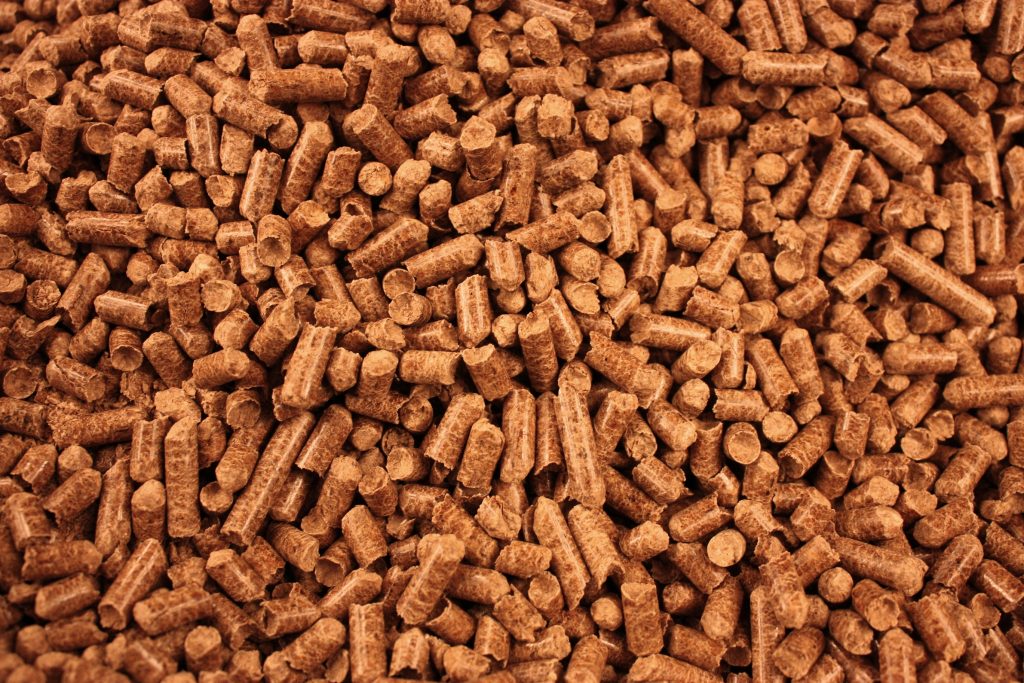
Hardwood Pellets
All forms of hardwoods like maple, oak or beech make a groovy substrate for several kinds of mushrooms. Just avoid using sawdust or pellets from softwood trees.
People use hardwood pellets for pellet stoves and grills and virtually hardwood stores carry them nowadays. They are quite inexpensive and in most places you tin find a 40 lb pocketbook for $5.
Y'all don't need the more expensive pellets fabricated from woods like hickory or apple which are used for smoking meats.
To brand a 10 pound block of substrate you lot'll need 10 cups of hardwood pellets and 2.8 liters of water. Wood pellets don't need to be sterilized, every bit the process of turning sawdust into pellets means they're already sterilized.
Still, most growers supplement their hardwood sawdust with bran. Wood solitary may not have the nutrients needed to abound some types of mushrooms.
And then ii and a one-half cups of wheat or oat bran can be added to provide extra nutrients for the mycelium. Adding bran means the whole mixture needs to be pasteurized or sterilized.
Some farmers also mix hardwood pellets with different ratios of soybean hulls for a like consequence. This combination is often referred to equally a "primary's mix" and tin produce some impressive yields.
Manure
We don't think that manure is an ideal growing medium for obvious reasons. Y'all don't want to be handling and heating upwards animal poop on a regular basis. However for some types of mushrooms, like mutual push button mushrooms, it's necessary.
You can use horse, chicken, cow, or other types of manure for mushrooms. Recipes usually call for ii parts manure with one part coco coir.
H2o and then needs to exist added to reach field capacity. That is basically the amount of water the substrate can agree without extra water pooling at the lesser. If you squeeze lightly, no water should come out and a difficult squeeze should produce only a few drops of water.
The whole mixture then needs to be sterilized before information technology tin can be inoculated with mushroom spawn.
Logs
Yes, even solid pieces of wood tin can be considered a substrate! Logs are often used to abound shiitake and other varieties of mushrooms outdoors.
Most hardwood varieties of copse can piece of work including beech, poplar, maple, oak, birch, elm and more.
Ideal logs for growing mushrooms are three to four anxiety long and iv to half dozen inches in diameter.
You don't desire to use wood that has been expressionless or dying for a while already. Other types of fungi may have already begun to colonize the woods and it can brand information technology harder for your desired mycelium to plant itself.
Freshly cutting logs should too be avoided equally trees take natural fungi-preventing properties while they're still alive. It'southward best to shop freshly cut logs somewhere make clean and dry for a few months before inoculating.
To inoculate a log, holes are drilled four to six inches into the log in rows. Utilise a v/16ths or 12 mm drill bit for optimal hole size. Rows are staggered two or three inches autonomously from each other.
Mycelium is introduced into the holes through the use of plug spawn. These are small pieces of wooden dowel that are colonized with mycelium that go hammered into the holes. Holes are so sealed with wax to prevent contamination.
We have an commodity titled How To Grow Mushrooms On Logs: The Ultimate Guide that goes through the whole process in more depth.
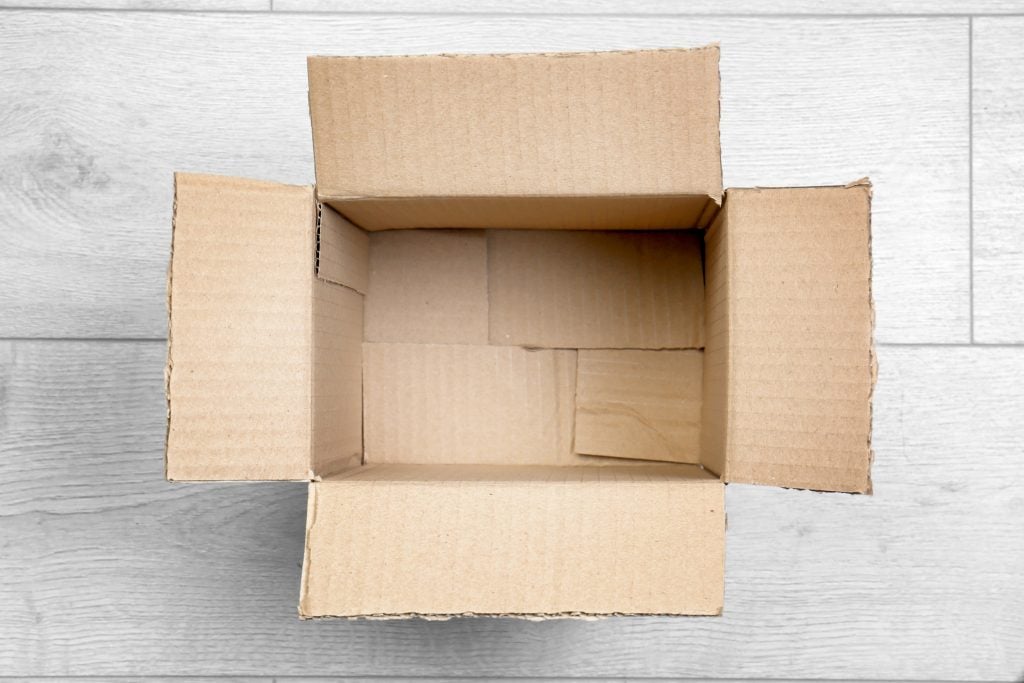
Paper-thin
Cardboard is a good substrate for beginners who are just getting started with growing mushrooms at dwelling. It's inexpensive and easy to find. Paper-thin retains wet well while the corrugations allow for good air exchange.
Oyster mushrooms and a few other ambitious species will grow on simply paper-thin, although it'southward helpful to mix information technology with coffee grounds or other supplements for best results.
You can even use paper-thin to abound mushroom spawn from the stems of oyster mushrooms that you buy at the grocery shop. All you need to practise is layer the mushroom between layers of clammy cardboard and mycelium volition start to grow.
Growing on cardboard is so uncomplicated that yous don't actually need a recipe. Just collect as much cardboard equally you want to use and and so soak it in boiling water.
Let your cardboard cool downward and squeeze out whatsoever excess water and then you lot're set up to add together mushroom pieces to colonize it.
How To Pasteurize or Sterilize Mushroom Substrates
Besides selecting a substrate to employ, deciding when it's advisable to either pasteurize or sterilize the material is another important function in learning how to make mushroom substrate.
Some people have very complicated mushroom growing setups that involve cleanrooms with negative air pressure and expensive equipment.
However nosotros've plant that this makes the process a lot more than complicated than it has to be, without a significant benefit. So nosotros opt for a more Low Tech Mushroom Farm growing fashion.
See our commodity How To Ready A Depression Tech Mushroom Farm for a total guide.
We discover that as long as y'all follow bones procedures for sterilization or pasteurization of your mushroom substrates, the risk of contamination is very low.
Keeping your surfaces make clean and wiping them down with 70% isopropyl alcohol during inoculation is all that is needed for well-nigh growers.
What's The Difference Between Pasteurizing or Sterilizing a Substrate?
Both pasteurizing and sterilizing substrate involve heating upwardly the substrate in an attempt to destroy existing bacteria or fungi, merely pasteurization heats substrate up to 185 degrees F, while sterilizing exposes the substrate to temperatures higher than 250 degrees F.
Keep reading to learn more differences.
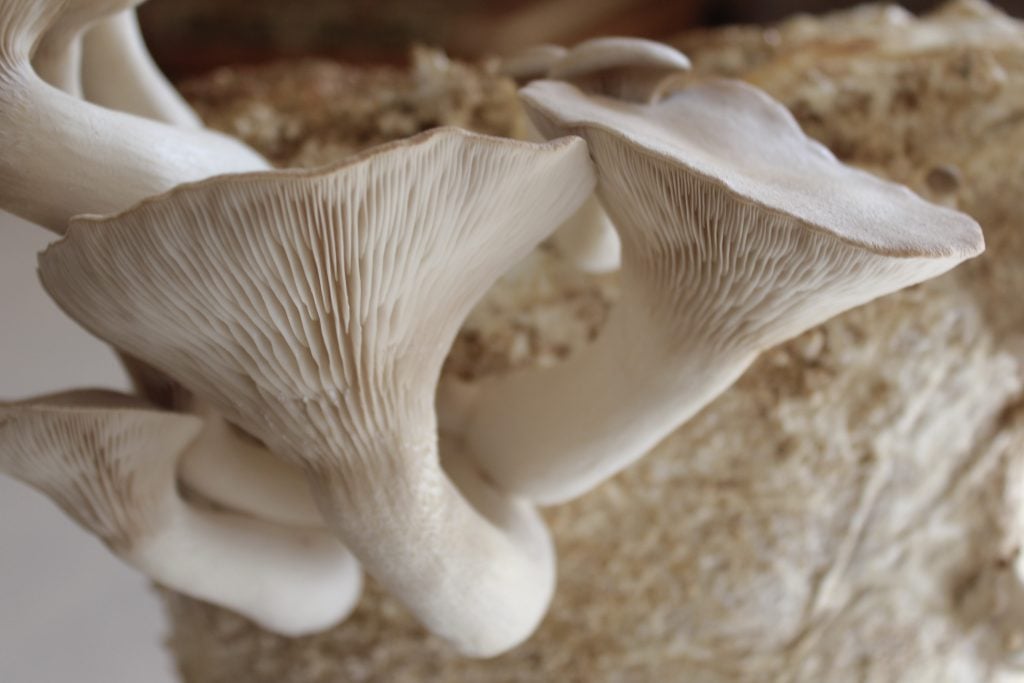
How To Pasteurize Mushroom Substrate
The purpose of pasteurization is to get the substrate fairly contaminate-free and gives whatsoever mushroom culture that you introduce a good head-start. In that location are two ways to pasteurize:
Hot H2o Bath Pasteurization
One way to pasteurize the substrate is simply to submerge information technology in boiling water for at least one or two hours. For most operations, we have found that pasteurization is sufficient to grow mushrooms with minimal risk of contamination.
Common cold Water Lime Pasteurization
To do this method, soak your substrate in a bathroom of hydrated lime-treated common cold water for 24 hours. This increases the pH of the water, killing contaminants in the process.
How To Sterilize Mushroom Substrate
Sterilization involves exposing the substrate to temperatures higher than 250 degrees F and as well involves placing the substrate under pressure. Sterilization aims to completely eliminate all contaminants that might be in the substrate, both living and currently fallow.
Just boiling a substrate doesn't get it hot enough to completely sterilize. For full sterilization, a pressure cooker or similar piece of equipment is needed.
How To Sterilize Mushroom Substrate Without A Pressure Cooker
There are a few ways that you can sterilize a substrate without using a pressure cooker.
A process called tyndallization or fractional sterilization can also be used. This is accomplished by humid jars or bags for a sure length of time over several days in a row.
The purpose of this is to impale both whatever microbial life that currently exists in the substrate, as well as any spores that may accept a few days earlier they brainstorm to abound.
Anything that gets your substrate above 250 degrees F for an extended period of fourth dimension can sterilize. This includes putting your substrate in an oven or autoclave.
However the problem with this is that it cooks your substrate and will completely dry out information technology out. Some substrates may too start to burn. If you lot sterilize your substrate this way, y'all'll need to employ distilled water to rehydrate it later while still keeping information technology sterile.
Why Is Pasteurization or Sterilization Necessary?
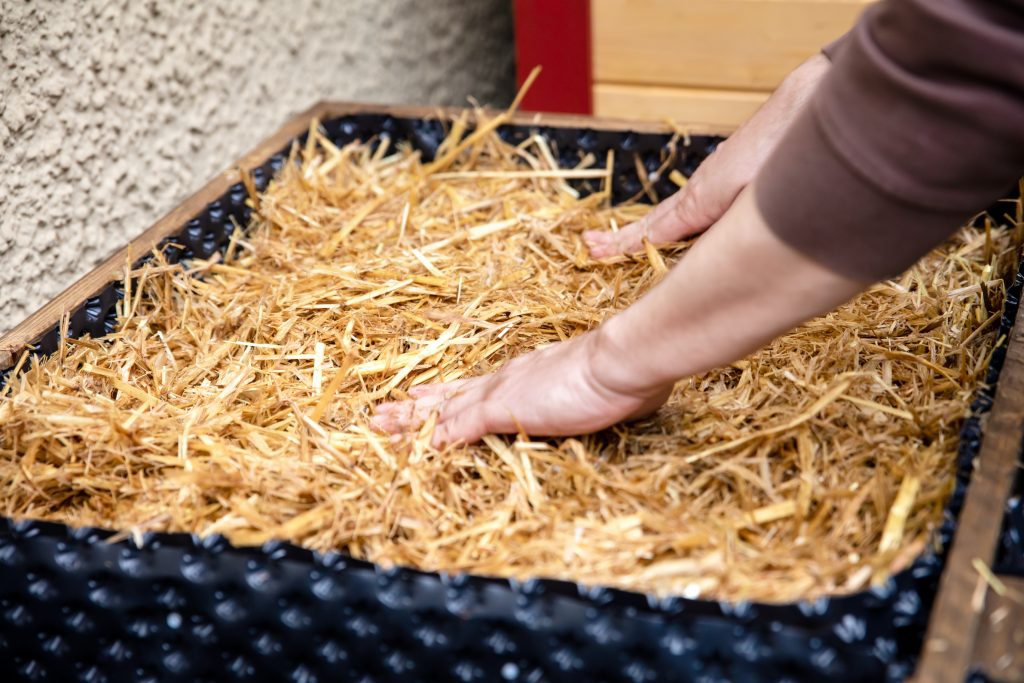
Pasteurization or sterilization reduce mold and bacteria and help ensure that the thing you're trying to grow will have the best chance to go established.
The substrates that mushrooms like to grow in are very moist and total of lots of nutrition. While that's an platonic environment for mushrooms, it's also the ideal weather for other things like mold and leaner to grow.
Bacteria and mold can grow faster than mushroom mycelium can. If left to nature, these contaminants will outperform mycelium and take command of the substrate before mushrooms have a chance to get established in most cases.
So we need to do something to give mushrooms a bit of a caput-start and ensure they colonize the substrate before other forms of mold or fungi can.
Pasteurizing your mushroom growing substrate is the equivalent of pulling as many weeds equally yous can out of the garden before planting vegetables. Sterilization is more similar scorching the earth and killing every living plant and seed in it.
Practice You Take To Sterilize Mushroom Substrate?
For some varieties of mushroom substrate, sterilizing is necessary to avert contamination. For other kinds of substrate you lot can get by with only pasteurizing it.
The near important factor in whether you need to sterilize or pasteurize is the nutrition content of the substrate.
Manure is a perfect example of a substrate that should ever be sterilized. By its very nature, it's already teeming full of bacteria and microbial life.
It might not seem like a very appealing habitat to humans. Just since it's made of partially-digested nutrient, it makes an like shooting fish in a barrel nutrient source for all kinds of different lifeforms.
Any substrate materials that could be considered food items need to exist sterilized for like reasons. This includes rye grain, popcorn, brown rice and wheat berries.
These substrates are all rich in nutrients and all kinds of different fungi and mold similar to abound on them. You've probably observed in your own kitchen how mold will start to grow on food after just a week or two.
Loftier-nutrient substrates need to be sterilized to give the mushrooms you're growing a head start.
Less nutritious substrates can be pasteurized instead of sterilized. A skillful example of this is straw. Straw is the dried stalks of diverse grain plants after all of the grain has been removed.
While it however has some nutrients left in it, it'southward not as nutrient-rich as grains themselves.
Coco coir, logs and cardboard similarly don't need to be sterilized. Pasteurization is enough to remove near of your mushroom's competition and give information technology a head start.
If you come across a new substrate that we haven't discussed here, merely enquire yourself one question to see if it's a material that should be pasteurized or sterilized. Is this something that a wild brute would eat?
Things like vermiculite and straw aren't an appealing food source for farm animals or even rodents. Meanwhile animals and even humans will swallow grains because they're full of nutrition.
One affair to watch out for is when mixing substrates, also known as supplementing them. You may add together a more than nutritious substrate to another to arrive more than nutritious.
For case, adding manure to hardwood sawdust. Hardwood pellets or sawdust wouldn't normally demand to be sterilized. Simply once you supplement it with another material that makes information technology easier for mold or bacteria to grow, sterilization becomes necessary.
If y'all're in doubt, y'all can sterilize any substrate to be extra safe. It just requires additional labor and equipment.
Fermentation of Straw every bit an Alternative to Pasteurizing
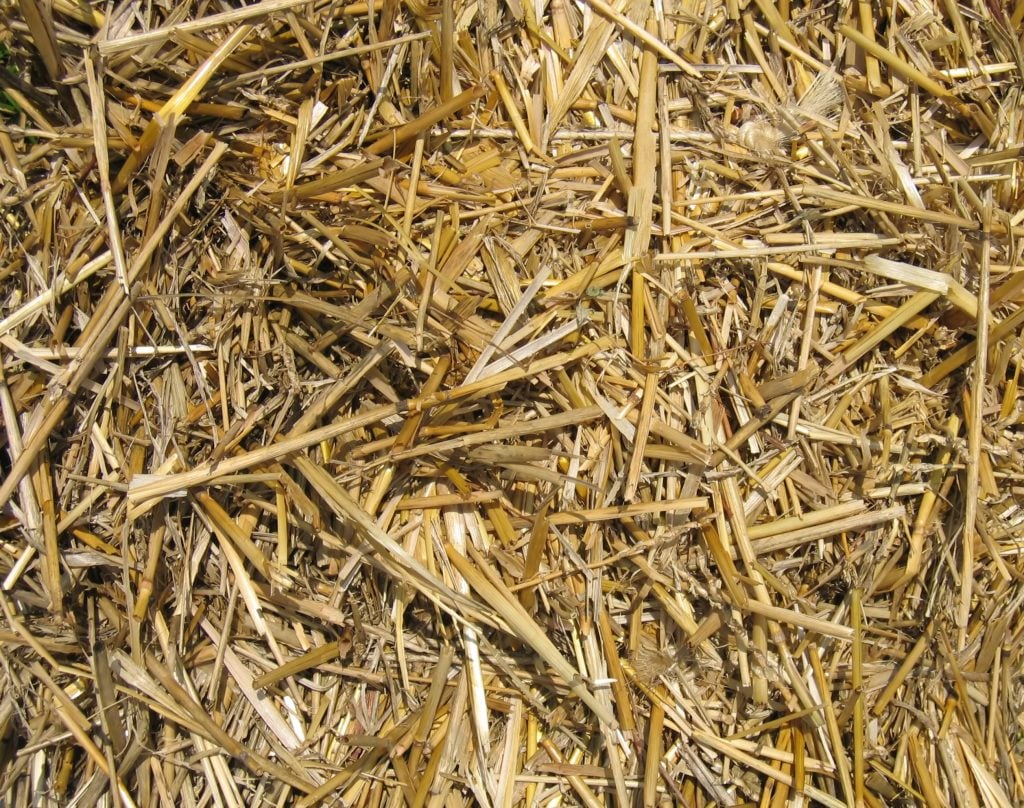
One affair mushroom growers can do instead of pasteurizing harbinger is to ferment information technology.
This involves submerging a bag total of straw underwater for about a week. If you're fermenting a whole straw bale you'll probably need to submerge information technology for longer, about two weeks.
During this fourth dimension, the straw starts to be broken down (fermented) by anaerobic organisms. These are types of bacteria that can merely survive in environments without oxygen.
Equally a result, all other organisms that usually crave oxygen to survive are killed off. One time the wet harbinger is drained exposed to air once again, all the anaerobic organisms are killed and the straw is substantially pasteurized.
One reason that nosotros adopt to pasteurize instead of ferment is that this technique quite literally stinks. Think about the process of fermenting foods like sauerkraut, kimchi or kombucha.
This is basically the same process just involving straw. If you use this method, y'all'll want to avoid getting any of the water on your easily or clothes. The smell is very hard to go off.
The other downside to fermenting instead of pasteurizing is the time and planning required. When you're fermenting, you'll need to predict what your substrate needs will be a calendar week or more out. If you're pasteurizing, your substrate can be ready to use in simply a few hours.
How Practice You lot Mix A Mushroom Substrate?
There's no easier way to mix substrate than only mixing information technology up with your hands. Of course, exist sure to wash your hands thoroughly earlier you begin and consider wearing a pair of dispensable gloves.
For bigger batches you can utilize a large spoon or even a shovel depending on how much substrate y'all're working with. Y'all can too use a compost tumbler which is what we use here at GroCyle), or you tin can apply a commercial substrate mixer.
Which Substrates Are All-time For Which Types of Mushrooms?
Equally nosotros've alluded to throughout this guide, dissimilar kinds of substrates are best suited to different mushroom species.
If you're asking yourself "What is the best mushroom substrate?" Unfortunately nosotros don't have one catch-all answer that applies to every situation. If it was that easy, every mushroom grower would but be using one ultimate substrate!
Some species of mushrooms like oyster mushrooms are very ambitious and can colonize a wide variety of materials. Others prefer forest-based substrates.
Some varieties of fungi like truffles even prefer to grow on the roots of living trees, which makes them notoriously difficult to grow in a commercial setting.
Choosing Your Substrate
Choosing your substrate comes down to a few choices:
- How much time and money do you want to put into growing mushrooms? If you want to go on your time and money input depression, await toward pasteurized substrates, not supplementing them, and choosing the species that grow well on those substrates.
- This is our arroyo at GroCycle and it scales up very well.
If you want to grow a wide range of gourmet mushrooms on a commercial scale and are okay with investing more fourth dimension and money, look toward supplemented materials and having a method to steam and sterilize the materials.
That will enable you lot to branch out into many types of mushrooms.
- What substrate is available to you? Logically, you'll desire to cull a substrate that'southward available to you locally. For case, if straw isn't abundant where you alive, you may effort coco coir.
Depression Tech Mushroom Substrate
If you do choose to go the low tech route to grow you mushrooms, good substrate options include harbinger, harbinger pellets, sawdust pellets, saccharide cane mulch, and coffee grounds. We'll explore several of these in more particular below.
Straw
Straw isn't very nutritious, then it'due south not well suited for all varieties of mushrooms. However information technology can be quite constructive for growing oyster mushroom species.
Other species of mushrooms that can grow on straw include agaricus species, wine cap (also known as garden giant), shaggy mane and enoki.
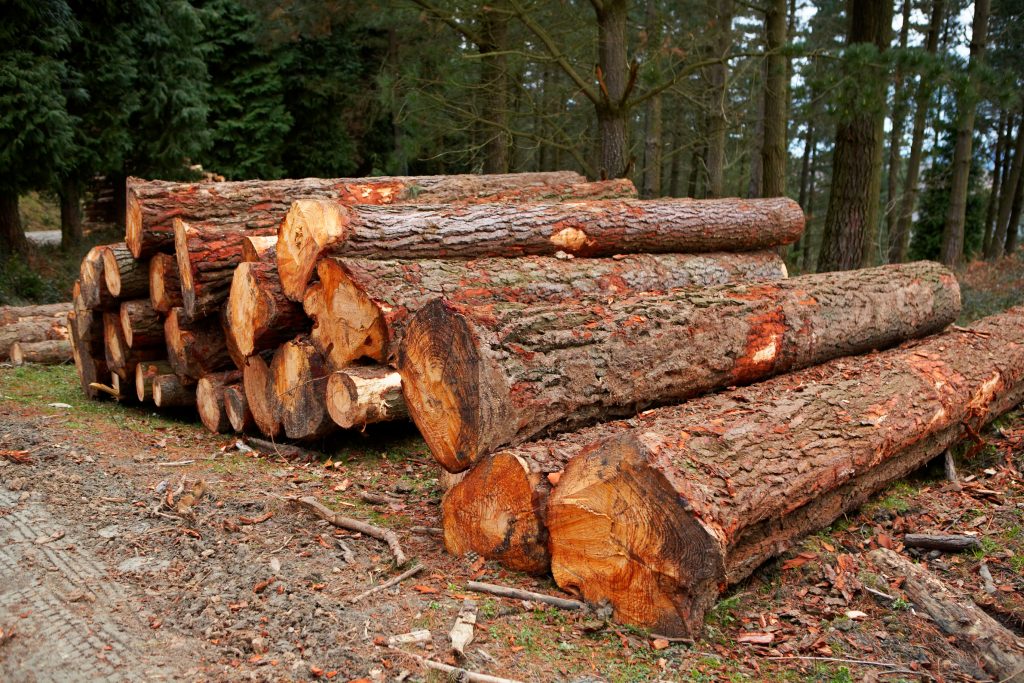
Logs or Sawdust
In that location are a wide variety of edible and medicinal forest-loving mushrooms. These include shiitake, maitake, turkey tail, lion'due south mane and reishi. Some types of oyster mushrooms will also grow well on wood. Especially rex oyster mushrooms, which prefer wood over straw as a substrate.
Most mushrooms that abound well on logs volition also grow on hardwood sawdust pellets or vice versa, since both are woods-based substrates.
Think that if you're using logs, you'll want them to be fairly fresh cut. Logs that are already dead or rotting may be abode to wild fungi and molds already.
Logs don't need to be sterilized before utilise. But go along in mind that since they're a more natural mushroom growing substrate material, they may exist home to other species of fungus that could produce poisonous mushrooms. This is rare.
But make sure that you know how to identify the species of mushroom that you're growing and take care that other types aren't mixed in by mistake.
Supplemented Sawdust
If you'd like to grow a wider range of mushrooms on sterilized substrate, endeavour a supplemented sawdust mix of lx% hardwood sawdust, xx% wood chips, 18% bran and 2% gypsum.
Masters Mix
Masters Mix, developed at Earth Angel Mushrooms is another simple substrate selection that consists of 50% hardwood pellets and 50% soybean pellets. It tends to outcome in very good yields, merely needs to exist sterilized.
If yous're in the United States, you tin buy bags of this already made from Mushroom Media Online.
Manure
You might remember that manure would be an ideal growing medium for mushrooms. Notwithstanding most species of edible mushrooms don't actually like information technology. The primary exceptions are button, crimini, and portobello mushrooms.
These are actually nevertheless species of mushroom at different life stages.
Java Grounds
Nosotros merely recommend growing oyster mushrooms on coffee grounds. This is a tried and tested combination.
A few other species of mushrooms like shiitake may abound on coffee grounds too, but might non produce as good of a harvest compared to growing on hardwood.
Mixes
Some materials like vermiculite have no nutritional value on their ain. However they may be mixed with other materials like coco coir or grain to provide better wet retention or other qualities.
Experimenting with dissimilar substrate mixes is something that you can try one time y'all've been growing mushrooms for a while.
However when yous're merely learning how to make mushroom substrate, we recommend sticking with a single substrate to begin with until you can produce a consistent harvest.
Supplementing Your Substrate
If you lot're thinking of growing mushrooms commercially, you may want to supplement your substrate to increase the yield of mushrooms. Most commonly, supplement materials are bran or seed derivatives.
Or, yous tin get them in pellet form as high-protein animal feed. The latter is preferably since it'due south already pasteurized.
You'll need to experiment to see how much supplementation to add together, and the amount will too depend on whether the material y'all're adding is sterilized. We recommend starting at v% and working your fashion upward.
What To Practice With Spent Mushroom Substrate
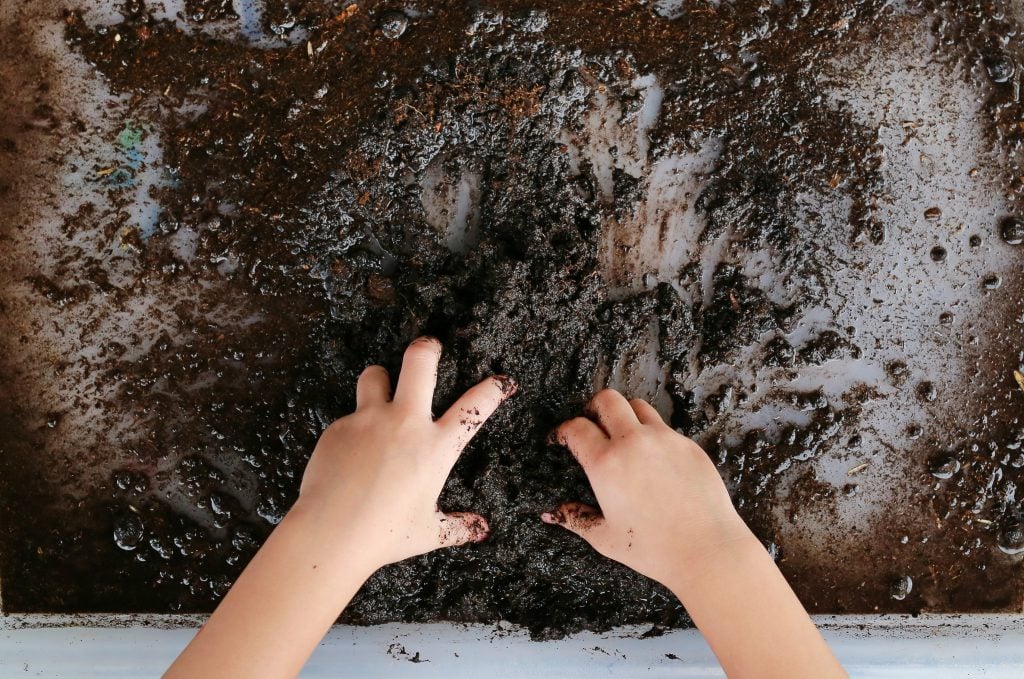
If yous've been growing mushrooms for whatever length of time, you'll soon end upwards with big piles of spent substrate. This might exit you request yourself "What can I do with an old mushroom substrate?" The near mutual pick for mushroom growers is to compost it.
It tin be mixed into an existing compost pile. Or you can create a compost pile out of just used substrate that will naturally decompose and interruption downward into a rich compost over fourth dimension.
If y'all've got a garden, you lot can fifty-fifty mix the used substrate right into the soil.
Some big commercial growers will even process their mushroom substrate and sell it as compost to home gardeners.
If you lot're lucky, y'all may get a few extra flushes of mushrooms from your compost pile or garden. Some species similar oyster mushrooms can fifty-fifty have concord and spread and yous'll go complimentary mushrooms growing in your garden yr afterwards yr.
Some of your spent substrate tin can likewise exist used to inoculate a new batch of substrate. That way you won't need to purchase mushroom spawn from suppliers and can have a truly self-sufficient operation. This kind of Low Tech Mushroom Farm may lead to slightly higher incidents of contamination though.
If y'all're a farmer with lots of space then it's easy to dispose of used substrate on your own. But what about people who are growing mushrooms in the city?
Nowadays many cities take a free composting program. Yous may exist able to dispose of the used substrate in compost bins that get emptied each week.
Or yous may need to drive the used substrate to a urban center depot that handles chiliad waste, compost and other recyclables to drop information technology off yourself.
If your urban center doesn't offer any way to recycle your substrate, you can achieve out to nearby farmers. They may want to add your used substrate to their own compost piles and will let y'all drib it off for gratis.
There accept even been studies on using mushroom substrates as an ingredient in feed mixes for chickens and cattle.
Final Thoughts
Selecting the correct substrate and preparing information technology correctly for the specific blazon of mushroom that y'all're growing is critical for your success.
Some species like oyster mushrooms can abound on a wide range of substrates including harbinger or fifty-fifty cardboard. Other species are more than detail and will but produce high yields when grown on a specific substrate.
One time y'all've selected the correct substrate yous'll need to either pasteurize or sterilize it to minimize the hazard of mold and bacteria growth. This part of the process helps requite your mycelium a caput-start in getting established.
Subsequently your mushrooms are done fruiting, you can dispose of spent substrate by composting it.
At present you know how to create an platonic substrate for your mushrooms. It's fourth dimension to become growing!
Source: https://grocycle.com/mushroom-substrate/
Posted by: taylorsuchers93.blogspot.com


0 Response to "How Do You Clean/sterelize An Old Chicken House"
Post a Comment